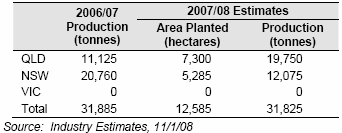Australia
January 16, 2008
Source:
Australian Oilseeds
Federation
 Canola 2007/08 Canola 2007/08
While there has been little
overall change in canola estimates, there has been some
significant shifts within
regions. The eastern states, particularly SA and Victoria, did
not perform as well as expected, whilst WA has show
considerable improvement.
Estimates for NSW are up slightly on last month. Victoria
continues to be the most difficult state to accurately
estimate tonnage. While there have been reports of excellent
yields in the Western District, overall production
appears to have finished below expectations. There is still some
crop to be harvested and a final reconciliation on numbers will
be provided next month. This may show some upside. South
Australia proved to be disappointing, with yields in medium
rainfall areas below expectations. While crops looked
reasonable, crops did not yield as estimated. Despite an average
start to the season, Western Australia continued to improve and
production has again been revised upwards.
 Sunflowers 2007/08 Sunflowers 2007/08
The sunflower crop has benefitted from the good rain through
Dec/Jan and the late plant is forecast to be up
significantly. It is now estimated that production will be
around 50,000 tonnes. Planting is still underway and
estimates will be finalised next month. The majority
(approximately 80%) of the crop is monounsaturated, with
the balance of area being polyunsaturated and confectionary
varieties.
There has been a significant late plant in southern Queensland
on the back of the good rain and strong prices.
There has been a small area planted in Central Queensland.
In the Moree region, the early plant crops are in the late
stages of grain fill and, with hot windy conditions over the
last 14 days, are fast approaching physiological maturity.
Isolated storms have continued to benefit some crops and
temperatures are only now reaching 36 degrees so the growing
season has been relatively mild compared to the last two
seasons. It is estimated that yields could average around
1.2t/ha at this stage. Growers are planting late crops mostly on
fallow country that has good moisture. However, there are some
cases where the moisture is quite variable due to storm rain and
planting is somewhat risky. The attractive hectare price offered
for monos and continued storm rains filling some profiles has
spurred the resurgence in late plant sunnies. Most started
planting just after Christmas and is still continuing.
In the Liverpool Plains, the long planting window on the early
plant has meant crop stage is now varied from just
finished flowering to approaching physiological maturity. The
early plant has benefited from significant rain during December
and some storm rain since Christmas. Generally the amounts
received have been highly variable across the plains. Heliothis
have been present, as is usually expected. Generally mild
conditions have assisted with crop progress and as such the
average yield is likely to be around 1.6t/ha with obvious
variations on this depending largely on in crop rainfall. The
late planting window commenced with some crops being sown in
December and planting still continuing. The warm temperatures
through early January have sped up crop emergence, with crops
reaching 2‐4 true leaves in 10‐14 days. Sowing moisture has
generally been excellent.
A reasonable proportion of the crop has been double cropped back
into winter cereal stubble where generally
profiles are between ½ to ¾ full. Hot, windy weather has
occurred in the last ten days drying out the surface
moisture, but with little effect currently.
 Soybeans 2007/08 Soybeans 2007/08
In a contrast to previous years, floods rather than drought
have seen soybean estimates fall by around 20%.
However, this comprises a fall of around 50% on the north coast
of NSW where floods have resulted in lost crops and an increase
in area of around 40% in Queensland.
Area planted has increased significantly on the Queensland coast
and the Darling Downs following good rain. This has seen area
planted in Queensland increase by almost 40%. Crops are
generally looking good. Weeds are a concern in coastal areas.
The north coast of NSW region has been hard hit by floods and
heavy rain and while uncertainty remains, it has been estimated
that more than two thirds of the crop has been lost. There may
be some opportunity to replant once the rain ceases. The inland
region has received good rain and this has resulted in good
subsoil moisture levels. Much of the crop in this area was
planted a bit late and area has been reduced a little. There has
been strong competition from attractively priced crop options
such as sunflower, sorghum and mung beans. In the Riverina, all
the crops are well established and starting to grow well now.
Many crops have only now received or are receiving their first
incrop irrigation. Excellent rains in November/December provided
a great start and the adequate moisture for sowing and
establishment.
|
|